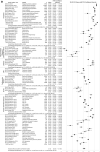Psychometric properties of the EQ-5D-5L: a systematic review of the literature
- PMID: 33284428
- PMCID: PMC7952346
- DOI: 10.1007/s11136-020-02688-y
Psychometric properties of the EQ-5D-5L: a systematic review of the literature
Abstract
Purpose: Although the EQ-5D has a long history of use in a wide range of populations, the newer five-level version (EQ-5D-5L) has not yet had such extensive experience. This systematic review summarizes the available published scientific evidence on the psychometric properties of the EQ-5D-5L.
Methods: Pre-determined key words and exclusion criteria were used to systematically search publications from 2011 to 2019. Information on study characteristics and psychometric properties were extracted: specifically, EQ-5D-5L distribution (including ceiling and floor), missing values, reliability (test-retest), validity (convergent, known-groups, discriminate) and responsiveness (distribution, anchor-based). EQ-5D-5L index value means, ceiling and correlation coefficients (convergent validity) were pooled across the studies using random-effects models.
Results: Of the 889 identified publications, 99 were included for review, representing 32 countries. Musculoskeletal/orthopedic problems and cancer (n = 8 each) were most often studied. Most papers found missing values (17 of 17 papers) and floor effects (43 of 48 papers) to be unproblematic. While the index was found to be reliable (9 of 9 papers), individual dimensions exhibited instability over time. Index values and dimensions demonstrated moderate to strong correlations with global health measures, other multi-attribute utility instruments, physical/functional health, pain, activities of daily living, and clinical/biological measures. The instrument was not correlated with life satisfaction and cognition/communication measures. Responsiveness was addressed by 15 studies, finding moderate effect sizes when confined to studied subgroups with improvements in health.
Conclusions: The EQ-5D-5L exhibits excellent psychometric properties across a broad range of populations, conditions and settings. Rigorous exploration of its responsiveness is needed.
Keywords: EQ-5D; EQ-5D-5L; Health-Related Quality of Life; Psychometric properties; Systematic review.
Conflict of interest statement
All four authors are members of the EuroQol group. Outside of scientific meetings, group members do not receive any financial support.
Figures








References
Works Cited
-
- Stolk E, Ludwig K, Rand K, van Hout B, Ramos-Goni JM. Overview, update, and lessons learned from the international EQ-5D-5L valuation work: Version 2 of the EQ-5D-5L valuation Protocol. Value in Health. 2019;22(1):23–30. - PubMed
-
- Bharmal M, Thomas J. Comparing the EQ-5D and the SF-6D descriptive systems to assess their ceiling effects in the US general population. Value in Health. 2006;9(4):262–271. - PubMed
-
- Luo N, Johnson JA, Shaw JW, Coons SJ. Relative efficiency of the EQ-5D, HUI2, and HUI3 index scores in measuring health burden of chronic medical conditions in a population health survey in the United States. Medical Care. 2009;47(1):53–60. - PubMed
-
- Tordrup D, Mossman J, Kanavos P. Responsiveness of the EQ-5D to clinical change: Is the patient experience adequately represented? International Journal of Technology Assessment in Health Care. 2014;30(1):10–19. - PubMed
References for publications included for review
-
- Scalone L. Comparing the standard EQ-5D-3L versus 5L version for the assessment of health of patients with live diseases. EuroQol Proceedings. 2011;16:213–239.
-
- Kim SH, Kim HJ, Lee SI, Jo MW. Comparing the psychometric properties of the EQ-5D-3L and EQ-5D-5L in cancer patients in Korea. Quality of Life Research. 2012;21(6):1065–1073. - PubMed
-
- van Hout B, Janssen MF, Feng YS, Kohlmann T, Busschbach J, Golicki D, Lloyd A, Scalone L, Kind P, Pickard AS. Interim scoring for the EQ-5D-5L: Mapping the EQ-5D-5L to EQ-5D-3L value sets. Value. Health. 2012;15(5):708–715. - PubMed
Publication types
MeSH terms
Grants and funding
LinkOut - more resources
Full Text Sources
Medical

